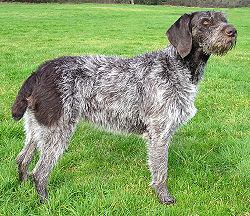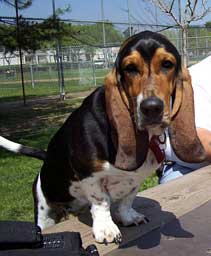Dog coats


A Stanford University School of Medicine study published in Science in October, 2007 found the genetics that explain coat colors in other mammals such as in horse coats and in cat coats, did not apply to dogs. [1] The project took samples from 38 different breeds to find the gene (a beta defensin gene) responsible for dog coat color. One version produces yellow dogs, and a mutation produces black. All dog coat colors are modifications of black or yellow. [2] For example, the white in white miniature schnauzers is a cream color, not albinism (a genotype of e/e at MC1R.)
Today, dogs exhibit a diverse array of fur coats, including dogs without fur, such as the Mexican Hairless Dog. Dog coats vary in texture, color, and markings, and a specialized vocabulary has evolved to describe each characteristic. [3]
Color
One often refers to a specific dog first by coat color rather than by breed; for example, "a blue merle Aussie" or "a chocolate Lab". Coat colors include:
- Black
- Brown : From mahogany through liver (dark brown). [3]
- Red : Reminiscent of reddish woods such as cherry or mahogany; also tawny, chestnut, orange, rusty, and red-gold. [3]
- Yellow: From pale cream to a deep yellowish-gold tan.
- Gold: From pale apricot to rich reddish-yellow.
- Gray: Pale to dark gray, including silver; can be mixed with other colors or various shades to create sandy pepper, pepper, grizzle, blue-black gray, or silver-fawn.
- Blue: A dark metallic gray, otherwise known as slate; diluted black pigment. Blue merle is genetically black, not blue. [3]
- Sable : Black-tipped hairs; the background color can be gold, silver, gray, or tan.
- White : Distinct from albino dogs.
- Buff : Such as the buff Cocker spaniel.
All these colors can also be dilute, meaning they become a paler shade of the original color. Blue and cream are both dilute colors. [3]
Pattern

Coat patterns include:
- Bicolor: such as black and tan, red and white. The coat has both colors but in clearly defined and separated areas; usually the top and sides are darker and lower legs and underside are the lighter color. [3]
- Tricolor: Consisting of three colors, usually black, tan, and white or liver, tan, and white. [3]
- Brindle : A mixture of black with brown, tan, or gold, usually in a "tiger stripe" pattern. [3] Sometimes called grizzle when the pattern is not in lines. [3]
- Roan : A kind of ticking on the hair where half the fur is one color and the other half is a different color. In English Setters, this color pattern is called a Belton pattern. [3]
- Harlequin: "Torn" patches of black on white. [3]
- Merle : Marbled coat with darker patches and spots of the specified color.
- Particolor: Two-colored coat with the colors appearing in patches in roughly equal quantities. [3]
- Tuxedo : Solid (usually black) with a white patch (shirt front) on the chest, and white on some or all of the feet (spats.) This pattern is sometimes called Irish Spotting, Flashy, or Boston. [3]
- Blenheim: A red and white pattern found in Cavalier King Charles Spaniels. [3]
- Domino: A specific facial and body pattern in Afghan Hounds caused by a certain genotype. [3]
Texture
Coat textures vary tremendously. Some coats make the dogs more cuddly and others make them impervious to cold water. Densely furred breeds such as most sled dogs and Spitz types can have up to 600 hairs per inch, while fine-haired breeds such as the Yorkshire Terrier can have as few as 100, and the "hairless" breeds such as the Mexican Hairless Dog and the Peruvian Inca Orchid have none on parts of their bodies. The texture of the coat often depends on the distribution and the length of the two parts of a dog's coat, its thick, warm undercoat (or down) and its rougher, somewhat weather-resistant outer coat (topcoat, also referred to as guard hairs ). Breeds with soft coats often have more or longer undercoat hairs than guard hairs; rough-textured coats often have more or longer guard hairs. Textures include:

- Double-coated: Having a thick, warm, short undercoat (or down) that is usually dense enough to resist penetration by water and a stronger, rougher weather-resistant outer coat (topcoat), also referred to as guard hairs. Most other coat types are also double-coated.
- Single-coated: Lacking an undercoat.
- Smooth-coated: "Smooth" to the eye and touch.
- Wire-haired: Also called broken-coated. The harsh outer guard hairs are prominent, providing excellent weather protection for hunting dogs such as the Border Terrier or Wirehaired Pointing Griffon.
- Long-haired: Hair longer than an inch or so.
- Short-haired: Hair around an inch or so long.
- Corded coat: for example, see Puli


